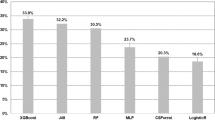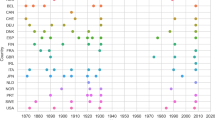Abstract
This paper is a comprehensive and complete research on bank failures that we examine from many different perspectives. It compromises a comprehensive dataset of ~60,000 observations for an extensive period (2005–2014) and examines different prediction horizons prior to failure. Moreover, we explore whether the addition of variables related to the diversification of the banks’ activities along with local effects, improve the predictability of the models. Seven popular and widely used machine learning techniques are compared under different performance metrics, using a bootstrap analysis. The results show that mid to long-term prediction improves significantly with the addition of diversification variables. Local effects exist and further improve the results, while, support vector machines, gradient boosting, and random forests outperform traditional models with the performance differences increasing over longer prediction horizons.
Access this chapter
Tax calculation will be finalised at checkout
Purchases are for personal use only
Similar content being viewed by others
References
Abdou H, Pointon J, El-Masry A (2008) Neural nets versus conventional techniques in credit scoring in Egyptian banking. Expert Syst Appl 35(3):1275–1292
Affes Z, Hentati-Kaffel R (2019) Predicting US banks bankruptcy: logit versus canonical discriminant analysis. Comput Econ 54:199–244
Al-Aidaroos KM, Bakar AA, Othman Z (2012) Medical data classification with Naive Bayes approach. Inf Technol J 11(9):1166–1174
Almeida TA, Almeida J, Yamakami A (2011) Spam filtering: how the dimensionality reduction affects the accuracy of Naive Bayes classifiers. Journal of Internet Services and Applications 1(3):183–200
Altman EI (1968) The prediction of corporate bankruptcy: a discriminant analysis. J Financ 23(1):193–194
Altman EI, Sabato G (2007) Modelling credit risk for SMEs: evidence from the U.S. market. Abacus 43(3):332–357
Amit Y, Geman D (1997) Shape quantization and recognition with randomized trees. Neural Comput 9(7):1545–1588
Androutsopoulos I, Koutsias J, Chandrinos KV, Spyropoulos CD (2000) An experimental comparison of naive Bayesian and keyword-based anti-spam filtering with personal e-mail messages. In Proceedings of the 23rd annual international ACM SIGIR conference on Research and development in information retrieval - SIGIR’00, pp 160–167
Arena M (2008) Bank failures and bank fundamentals: a comparative analysis of Latin America and East Asia during the nineties using bank-level data. J Bank Financ 32(2):299–310
Awad WA, ELseuofi SM (2011) Machine learning methods for spam e-mail. Int J Comput Sci Inf Technol 3(1):173–184
Baele L, Jonghe OD, Venner RV (2007) Does the stock market value bank diversification? J Bank Financ 31:1999–2023
Baesens B, Van Gestel T, Viaene S, Stepanova M, Suykens JAK, Vanthienen J (2003) Benchmarking state of the art classification algorithms for credit scoring. J Oper Res Soc 54(6):627–635
Beaver (1966) Financial ratios as predictors of failure. Empirical research in accounting: selected studies 1966. J Account Res 4:71–111
Becchetti L, Sierra J (2003) Bankruptcy risk and productive efficiency in manufacturing firms. J Bank Financ 27(11):2099–2120
Beltratti A, Stulz RM (2012) The credit crisis around the globe: why did some banks perform better? J Financ Econ 105(1):1–17
Betz F, Opric S, Peltonen TA, Sarlin P (2014) Predicting distress in European banks. J Bank Financ 45(1):225–241
Bharath ST, Shumway T (2008) Forecasting default with the Merton distance to default model. Rev Financ Stud 21(3):1339–1369
Bishop CM (1995) Neural networks for pattern recognition. Oxford University Press, New York
Bosch A, Zisserman A, Mu X, Munoz X (2007) Image classification using random forests and ferns. In: IEEE 11th international conference on computer vision (ICCV), pp 1–8
Breiman L (1996) Bagging predictors. Mach Learn 24(2):123–140
Breiman L (2001) Random forests. Mach Learn 45(1):5–32
Brown I, Mues C (2012) An experimental comparison of classification algorithms for imbalanced credit scoring data sets. Expert Syst Appl 39(3):3446–3453
Carmona P, Climent F, Momparler A (2019) Predicting bank failure in the U.S. banking sector: an extreme gradient boosting approach. Int Rev Econ Financ 61:304–323
Chen MY (2011) Predicting corporate financial distress based on integration of decision tree classification and logistic regression. Expert Syst Appl 38(9):11261–11272
Chen T, Guestrin C (2016) XGBoost. In: Proceedings of the 22nd ACM SIGKDD International Conference on Knowledge Discovery and Data Mining - KDD ’16, pp. 785–794
Chen T, He T (2015) xgboost : eXtreme Gradient Boosting. R Package Version 0.4-2, 1–4
Chen J, Huang H, Tian S, Qu Y (2009) Feature selection for text classification with Naïve Bayes. Expert Syst Appl 36:5432–5435
Cleary S, Hebb G (2016) An efficient and functional model for predicting bank distress: in and out of sample evidence. J Bank Financ 64:101–111
Cole RA, White LJ (2012) Déjà vu all over again : the causes of U. S. commercial bank failures this time around. J Financial Serv Res 42(1–2):5–29
Cox RAK, Wang GWY (2014) Predicting the US bank failure: a discriminant analysis. Econ Anal Pol 44(2):202–211
Crook JN, Edelman DB, Thomas LC (2007) Recent developments in consumer credit risk assessment. Eur J Oper Res 183(3):1447–1465
Demyanyk Y, Hasan I (2009) Financial crisis and bank failure: a review of prediction methods. Omega 38(5):315–324
Desai VS, Crook JN, Overstreet GA (1996) A comparison of neural networks and linear scoring models in the credit union environment. Eur J Oper Res 95(1):24–37
Díaz-Uriarte R, Alvarez de Andrés S (2006) Gene selection and classification of microarray data using random forest. BMC Bioinf 7(3)
Doumpos M, Zopounidis C (1998) The use of the preference disaggregation analysis in the assessment of financial risks. Fuzzy Econ Rev 3(1):39–57
Doumpos M, Gaganis C, Pasiouras F (2016) Bank diversification and overall financial strength: international evidence. Financ Mark Inst Instrum 25(3):169–213
Flannery MJ (1998) Using market information in prudential bank supervision: a review of the U.S. empirical evidence. J Money Credit Bank 30(3):273–305
Freund Y, Schapire RE (1996) Experiments with a new boosting algorithm. In: Proceedings of the thirteenth international conference on machine learning, Vol. pages, pp 148–156
Friedman JH (2001) Greedy function approximation: a gradient boosting machine. Ann Stat 29(5):1189–1232
Friedman JH (2002) Stochastic gradient boosting. Comput Stat Data Anal 38(4):367–378
Hand DJ (2009) Measuring classifier performance: a coherent alternative to the area under the ROC curve. Mach Learn 77(1):103–123
Hastie T, Tibshirani R, Friedman J (2009) The elements of statistical learning. Springer, New York
Ho TK (1998) The random subspace method for constructing decision forests. IEEE Trans Pattern Anal Mach Intell 20(8):832–844
Hosmer DW, Lemeshow S (1989) Applied logistic regression. Wiley, New York
Ince H, Trafalis TB (2006) A hybrid model for exchange rate prediction. Decis Support Syst 42(2):1054–1062
Kharya S, Soni S (2016) Weighted Naive Bayes classifier: a predictive model for breast cancer detection. Int J Comput Appl 133(9):32–37
Kharya S, Durg C, India CG, Soni S (2014) Naive Bayes classifiers: a probabilistic detection model for breast cancer Shika Agrawal. Int J Comput Appl 92(10):975–8887
Kolari J, Glennon D, Shin H, Caputo M (2002) Predicting large US commercial bank failures. J Econ Bus 54(4):361–387
Laeven L, Levine R (2007) Is there a diversification discount in financial conglomerates? J Financ Econ 85(2):331–367
Lenard MJ, Alam P, Madey GR (1995) The application of neural networks and a qualitative response model to the auditor’s going concern uncertainty decision. Decis Sci 26(2):209–227
López Iturriaga FJ, Sanz IP (2015) Bankruptcy visualization and prediction using neural networks: a study of U.S. commercial banks. Expert Syst Appl 42(6):2857–2868
Männasoo K, Mayes DG (2009) Explaining bank distress in eastern European transition economies. J Bank Financ 33(2):244–253
Martens D, Baesens B, Van Gestel T, Vanthienen J (2007) Comprehensible credit scoring models using rule extraction from support vector machines. Eur J Oper Res 183(3):1466–1476
Mascaro J, Asner GP, Knapp DE, Kennedy-Bowdoin T, Martin RE, Anderson C et al (2014) A tale of two “forests”: random forest machine learning aids tropical forest carbon map**. PLoS One 9(1):e85993
McLeay S, Omar A (2000) The sensitivity of prediction models to the non-normality of bounded and unbounded financial ratios. Br Account Rev 32(2):213–230
Min JH, Lee Y-C (2005) Bankruptcy prediction using support vector machine with optimal choice of kernel function parameters. Expert Syst Appl 28(4):603–614
Ooghe H, De Bourdeaudhuij C, Joos P (1995) Financial distress models in Belgium: the results of a decade of empirical research. Int J Account 31(3):245–274
Pal M (2005) Random forest classifier for remote sensing classification. Int J Remote Sens 26(1):217–222
Park H, Konishi S (2016) Robust logistic regression modelling via the elastic net-type regularization and tuning parameter selection. J Stat Comput Simul 86(7):1450–1461
Park H, Kim N, Lee J (2014) Parametric models and non-parametric machine learning models for predicting option prices: empirical comparison study over KOSPI 200 index options. Expert Syst Appl 41(11):5227–5237
Ravi Kumar P, Ravi V (2007) Bankruptcy prediction in banks and firms via statistical and intelligent techniques – a review. Eur J Oper Res 180(1):1–28
Sarkar S, Sriram RS (2001) Bayesian models for early warning of bank failures. Manag Sci 47(11):1457–1475
Tanaka K, Kinkyo T, Hamori S (2016) Random forests-based early warning system for bank failures. Econ Lett 148:118–121
Tsai CF, Hsu YF, Yen DC (2014) A comparative study of classifier ensembles for bankruptcy prediction. Appl Soft Comput J 24:977–984
Vapnik V (1995) The nature of statistical learning theory. Springer, New York
Zopounidis C, Dimitras AI (1998) Multicriteria decision aid methods for the prediction of business failure. Springer, New York
Author information
Authors and Affiliations
Corresponding author
Editor information
Editors and Affiliations
Rights and permissions
Copyright information
© 2021 Springer Nature Switzerland AG
About this chapter
Cite this chapter
Manthoulis, G., Doumpos, M., Zopounidis, C., Galariotis, E., Baourakis, G. (2021). Bank Failure Prediction: A Comparison of Machine Learning Approaches. In: Zopounidis, C., Benkraiem, R., Kalaitzoglou, I. (eds) Financial Risk Management and Modeling. Risk, Systems and Decisions. Springer, Cham. https://doi.org/10.1007/978-3-030-66691-0_10
Download citation
DOI: https://doi.org/10.1007/978-3-030-66691-0_10
Published:
Publisher Name: Springer, Cham
Print ISBN: 978-3-030-66690-3
Online ISBN: 978-3-030-66691-0
eBook Packages: Business and ManagementBusiness and Management (R0)




